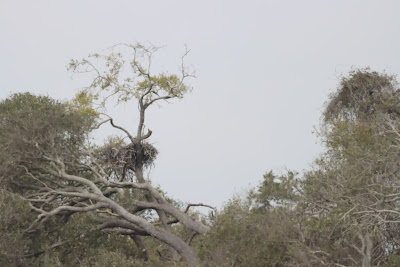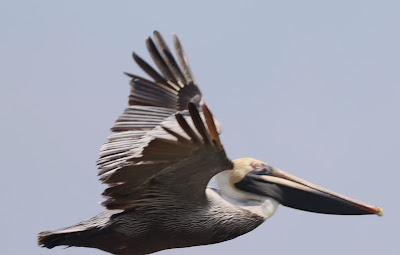Tuesday, March 21, 2023
Part 2, Birding at the Aransas National Wildlife Refuge
Barb drove their jeep and Dan and I sat with our cameras in our laps. Usually there are raptors on many of the electrical poles but we never saw a single one . Arriving at the Aransas National Wildlife Refuge we stopped at the new refuge headquarters. Renita posed next to a life size statue of a whooping crane, for scale but there were no other displays.
Apparently they were still finishing them so hopefully we will see them when we come back in the fall. Leaving the headquarters, we next drove to Jones lake. A flock of blue winged teals took off as we walked out onto the platform. Feral hogs were rooting up the grass in the distance and a deer grazed as an alligator swam towards us.
A pair of pied bill grebes exhibited their courtship dance, not caring the least about us taking images. A bird was singing and using the Merlin app it identified the song as from a white eyed vireo. Later I got a great image of a white eyed vireo as we walked the Heron Flats Trail.
From Jones Lake our next stop was at the Observation Towers where, as usual we saw a family of whooping cranes several miles away. Its their usual territory and if you want to see them up close you need to take a cruise on the Skimmer, which is a great birding adventure!
Several black vultures at on a tree top and taking the boardwalk out to the bay, we were rewarded with shots of a great blue in flight, and a white morph great blue heron. We watched as a shore bird found and tried to devour a small blue crab. It seemed to be bothered by its small claws and eventually gave up its meal plans. Driving the eleven mile road we hoped to see a nesting pair of bald eagles but they had abandoned the nest.
After the Eleven mile road we stopped for lunch at the picnic area and then drove to the Heron Flats Trail. A reddish egret exhibited it “drunken walk”, as it hunted and caught a crawfish, (which it had a heck of a time swallowing). Most herons and egrets slowly wade as they fish but the reddish egret, including a white morph will run erratically after it spots its prey.
A brown pelican flew by. Its hard to believe that the birds almost went extinct due to the widespread use of DDT. A book describng the bird loss came out in the sixties, titled Silent Spring. A large group of rosette spoonbills slept on a small island sharing their resting spot with a couple of double crested cormorants and a snowy egret. Our last bird of the day was one we had already spotted. It was a flight picture of a lesser yellowlegs. It was a great picture to end the day. Thanks for driving Barb! Clear skies
As usual my identification of several of the birds may be wrong so if you disagree, please comment.
Thursday, March 16, 2023
Aransas National Wildlife Refuge. March 2023 (Part 1 Alligators)
Barb and Renita were a little ahead of us and we were all visiting when Renita called out snake. Dan and I hurried up hoping to get a photograph before it disappeared into the thick brush. Just as fast the snake moved into the dense foliage and we decided we didn’t want to go in any further.
It was our first trip to the refuge since the new headquarters had been built. Dan and Barb joined us on a birding adventure and a fun day hiking and driving the trails. Stopping at the Heron Flat trails we did not see the pair of whoopers that had claimed the salt flats as their territory. Before we reached the blind another birder told us of the large alligator that had walked across the trial and was floating in the southern pond.
As we headed down the trail looking for birds, a second large alligator was sunning itself on the bank. A third lay in the water partially submerged, and worked its way toward us measuring us for prey? It watched us with its yellow reptilian eys. The alligator may have been fed by other visitors as they usually stay away from people. A fed alligator is like a fed bear, slated for euthanasia. It finally stopped and didn’t cross our trail although we could see tail marks and claw marks where one had crossed to the next brackish pond.
A little further and yet a fifth large gator slowly swam by and at the next fresh water pond a sixth waited. It’s not unusual to see so many large gators and we saw a seventh, which we photographed at the platform on Jones Lake. We eventually passed all the ponds and gators took photos of the birds but that’s for part two of this story.
Later, Renita told us the snake stretched completely across the trail which meant it was at least six feet long. It had a dark color, but she never could identify it. Here in south Texas there are copper heads, coral snakes water moccasins and Western Diamondbacks which can grow up to eight feet in length, (and many non poisonous ones). Dan and I wisely did not chase the snake into the thick underbrush.
Gators are almost as fun as bears, and it was a good start for the day!
Clear skies
Thursday, March 9, 2023
The Gulf Coast Gem and Mineral Show, The 60th Anniversary
Our first major show of each year is the Gulf Coast Gem and Mineral Societies annual event. It held at the Fairgrounds in Robstown, Texas, lasts two days and is a juried show. All the venders must be selling items related to rocks fossils and minerals. The number of venders is usually under thirty.
The venders specialize in, rare minerals, carved and rough rocks, jewelry, and lapidary supplies. Although its one of the smaller shows we love showing our work. The reason for this is that the club mentored us and taught us how to select, saw, grind, and polish each one noting its special properties.
We have been blessed in many ways havin learned under several Masters. Jerald Simpson taught us how to make cabochons from a rock slab, (a sawed slice of a rock). Dick Cline (a retired elctrician who worked on numerous nuclear power plants world wide and passed away at age 93), taught us how to saw and identify quality specimens. He insisted that we only work with high quality rock. He often told us life is too short to waste your time on “junk”.
In turn we have taught our wire wrapping techniques to many in the club, some of which are in the following pictures. Thank you to all the members, both past and present.
Russell is the current president, and a petroleum geologist, an extremely smart man, (but aren’t all geologists), Henri our current treasurer, Sue, and Jose. All have taken our class. Linda Simpson is holding down the information booth and identifing specimens brought in by our guests, She is a retired Earth Science teacher, (another group of smart people).
Rita is the current secretary, and has an avid interest in collecting Pleistocene fossils, modern bones, antlers, and petrified wood. She combines them into a multimedia pieces on display, Here she is running the silent Auction tables where anyone can bid on club and member pieces.
The club currently has lost our lapidary shop and we hope that they will be able to find a space as we have all the equipment in storage, (we rented a space from the City of Corpus Christi, Tx, and have been forced to leave as the new Harbor bridge and surrounding area plans have claimed the building we occupied as our shop.
Thank you all, we hold you in our hearts! Clear skies
Friday, March 3, 2023
Osprey stare down, Whoopers at Lamar, and Rosette Spoonbills
It been a while since our last entry, because we have been finishing jewelry and necklaces for our space at the Gulf Coast Gem and Mineral Show. It’s the Gulf Coast Gem and Mineral's 60th Show, and as usual will be held at the Fairgrounds in Robstown, Texas.
We decided we needed a break and so we grabbed our cameras for a quick trip to Lamar. There are not many places in the world where such beautiful and endangered species are so easy to spot. After crossing the Copano Bay Bridge we headed down along St Charles Bay and found three whooping cranes watching a feeder.
As you can see one is telling the others something but as we don’t speak bird language we can only guess… Leaving the three cranes we next headed to Eighth Street where we spotted a large flock of Rosette Spoonbills with immature sand hill cranes feeding among them.
The spoonbills are in their breeding colors, which are shades of bright pink, a palette of unique colors in nature. You can also see that a couple of the birds have claimed a spot for their nests. Driving further we had a stare down with an osprey, watching us as we took its picture. Ospreys always seem to have a glare on their face as they decide if you prey that is just too big to eat.
As we watched another set of whoopers. we saw one doing its stretch. It’s a common whooper stretch that they often engage in after taking an afternoon siesta. There were a lot of people around, (President’s Day), and so we didn’t see much else.
An Eastern peewee hunted near Big Tree but didn’t pose long enough for a good picture. Reaching the shoreline, we saw a woman flyfishing but she didn’t catch any fish while we watched. Four kayakers were also fishing but again we didn’t see any sign of action.
Still it was a productive birding trip and a good break from our jewelry benches, (a tv table in front of the couch and the dining table. Today we are going to Robstown to set up.
Clear skies
Subscribe to:
Posts (Atom)


































